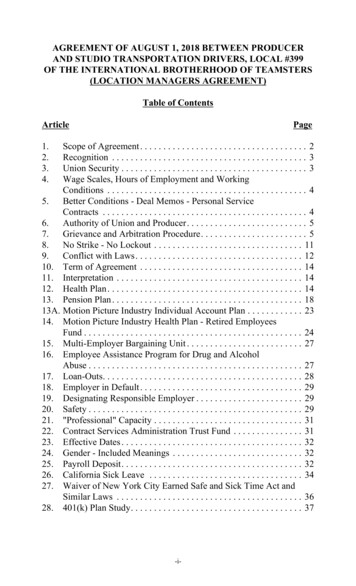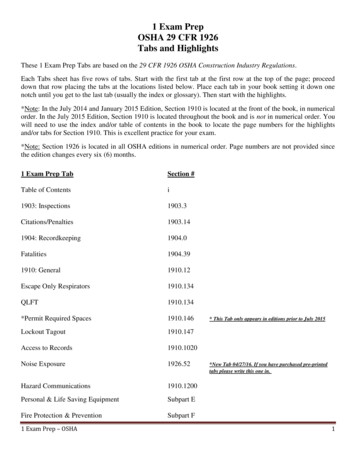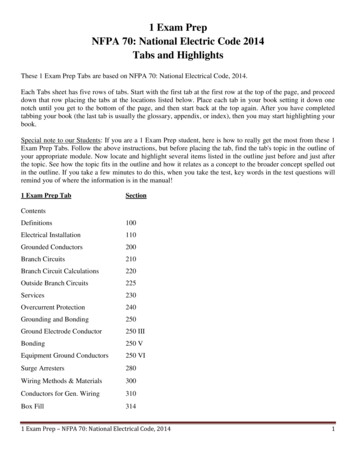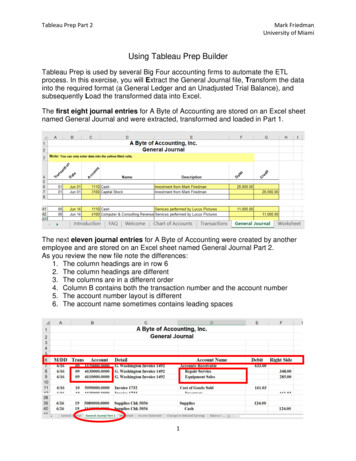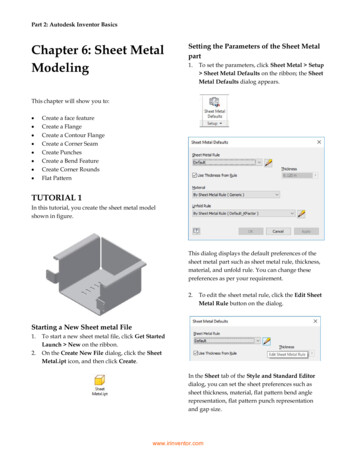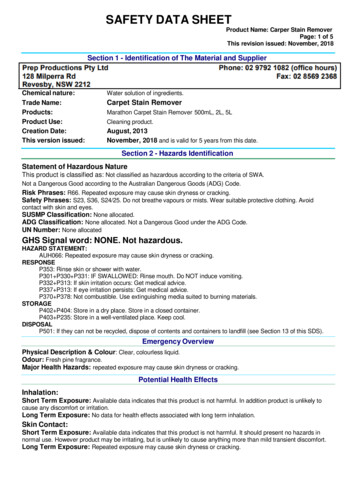
Transcription
SAFETY DATA SHEETProduct Name: Carper Stain RemoverPage: 1 of 5This revision issued: November, 2018Section 1 - Identification of The Material and SupplierChemical nature:Trade Name:Products:Product Use:Creation Date:This version issued:Water solution of ingredients.Carpet Stain RemoverMarathon Carpet Stain Remover 500mL, 2L, 5LCleaning product.August, 2013November, 2018 and is valid for 5 years from this date.Section 2 - Hazards IdentificationStatement of Hazardous NatureThis product is classified as: Not classified as hazardous according to the criteria of SWA.Not a Dangerous Good according to the Australian Dangerous Goods (ADG) Code.Risk Phrases: R66. Repeated exposure may cause skin dryness or cracking.Safety Phrases: S23, S36, S24/25. Do not breathe vapours or mists. Wear suitable protective clothing. Avoidcontact with skin and eyes.SUSMP Classification: None allocated.ADG Classification: None allocated. Not a Dangerous Good under the ADG Code.UN Number: None allocatedGHS Signal word: NONE. Not hazardous.HAZARD STATEMENT:AUH066: Repeated exposure may cause skin dryness or cracking.RESPONSEP353: Rinse skin or shower with water.P301 P330 P331: IF SWALLOWED: Rinse mouth. Do NOT induce vomiting.P332 P313: If skin irritation occurs: Get medical advice.P337 P313: If eye irritation persists: Get medical advice.P370 P378: Not combustible. Use extinguishing media suited to burning materials.STORAGEP402 P404: Store in a dry place. Store in a closed container.P403 P235: Store in a well-ventilated place. Keep cool.DISPOSALP501: If they can not be recycled, dispose of contents and containers to landfill (see Section 13 of this SDS).Emergency OverviewPhysical Description & Colour: Clear, colourless liquid.Odour: Fresh pine fragrance.Major Health Hazards: repeated exposure may cause skin dryness or cracking.Potential Health EffectsInhalation:Short Term Exposure: Available data indicates that this product is not harmful. In addition product is unlikely tocause any discomfort or irritation.Long Term Exposure: No data for health effects associated with long term inhalation.Skin Contact:Short Term Exposure: Available data indicates that this product is not harmful. It should present no hazards innormal use. However product may be irritating, but is unlikely to cause anything more than mild transient discomfort.Long Term Exposure: Repeated exposure may cause skin dryness or cracking.
Product Name: Carpet Stain RemoverPage: 2 of 5This revision issued: November, 2018Eye Contact:Short Term Exposure: This product is believed to be mildly irritating, to eyes, but is unlikely to cause anythingmore than mild transient discomfort.Long Term Exposure: No data for health effects associated with long term eye exposure.Ingestion:Short Term Exposure: Significant oral exposure is considered to be unlikely. However, this product is believed tobe mildly irritating to mucous membranes but is unlikely to cause anything more than mild transient discomfort.Long Term Exposure: No data for health effects associated with long term ingestion.Carcinogen Status:SWA: No significant ingredient is classified as carcinogenic by SWA.NTP: No significant ingredient is classified as carcinogenic by NTP.IARC: No significant ingredient is classified as carcinogenic by IARC.Section 3 - Composition/Information on IngredientsIngredientsCAS NoConc,%TWA (mg/m3) STEL (mg/m3)Nonionic surfactantsecret5-15not setnot setNon hazardous solventsecret3-6not setnot setOther non hazardous ingredientsvarious5-15not setnot setWater7732-18-5to 100not setnot setThis is a commercial product whose exact ratio of components may vary slightly. Minor quantities of other nonhazardous ingredients are also possible.The SWA TWA exposure value is the average airborne concentration of a particular substance when calculated over a normal 8 hour working dayfor a 5 day working week. The STEL (Short Term Exposure Limit) is an exposure value that may be equalled (but should not be exceeded) for nolonger than 15 minutes and should not be repeated more than 4 times per day. There should be at least 60 minutes between successive exposuresat the STEL. The term "peak "is used when the TWA limit, because of the rapid action of the substance, should never be exceeded, even briefly.Section 4 - First Aid MeasuresGeneral Information:You should call The Poisons Information Centre if you feel that you may have been poisoned, burned or irritated bythis product. The number is 13 1126 from anywhere in Australia (0800 764 766 in New Zealand) and is available at alltimes. Have this SDS with you when you call.Inhalation: First aid is not generally required. If in doubt, contact a Poisons Information Centre or a doctor.Skin Contact: Wash gently and thoroughly with water (use non-abrasive soap if necessary) for 5 minutes or untilchemical is removed.Eye Contact: Immediately flush the contaminated eye(s) with lukewarm, gently flowing water for 5 minutes or untilthe product is removed, while holding the eyelid(s) open. Obtain medical advice immediately if irritation occurs. Takespecial care if exposed person is wearing contact lenses.Ingestion: If product is swallowed or gets in mouth, do NOT induce vomiting; wash mouth with water and give somewater to drink. If symptoms develop, or if in doubt contact a Poisons Information Centre or a doctor.Section 5 - Fire Fighting MeasuresFire and Explosion Hazards: The major hazard in fires is usually inhalation of heated and toxic or oxygendeficient (or both), fire gases. There is no risk of an explosion from this product under normal circumstances if it isinvolved in a fire.Only small quantities of decomposition products are expected from this product at temperatures normally achieved ina fire. This will only occur after heating to dryness.Fire decomposition products from this product are not expected to be hazardous or harmful.Extinguishing Media: Not combustible. Use extinguishing media suited to burning materials.Fire Fighting: If a significant quantity of this product is involved in a fire, call the fire brigade.Flash point:Does not burn.Upper Flammability Limit:Does not burn.Lower Flammability Limit:Does not burn.Autoignition temperature:Not applicable - does not burn.Flammability Class:Does not burn.SAFETY DATA SHEETIssued by: Prep Productions Pty LtdPhone: 02 9792 1082Poisons Information Centre: 13 1126 from anywhere in Australia, (0800 764 766 in New Zealand)
Product Name: Carpet Stain RemoverPage: 3 of 5This revision issued: November, 2018Section 6 - Accidental Release MeasuresAccidental release: Minor spills do not normally need any special cleanup measures. In the event of a major spill,prevent spillage from entering drains or water courses. As a minimum, wear overalls, goggles and gloves. Suitablematerials for protective clothing include rubber, PVC. Eye/face protective equipment should comprise as a minimum,protective glasses and, preferably, goggles. If there is a significant chance that vapours or mists are likely to build upin the cleanup area, we recommend that you use a respirator. Usually, no respirator is necessary when using thisproduct. However, if you have any doubts consult the Australian Standard mentioned below (section 8).Stop leak if safe to do so, and contain spill. Absorb onto sand, vermiculite or other suitable absorbent material. If spillis too large or if absorbent material is not available, try to create a dike to stop material spreading or going into drainsor waterways. Sweep up and shovel or collect recoverable product into labelled containers for recycling or salvage,and dispose of promptly. Recycle containers wherever possible after careful cleaning. After spills, wash areapreventing runoff from entering drains. If a significant quantity of material enters drains, advise emergency services.This material may be suitable for approved landfill. Ensure legality of disposal by consulting regulations prior todisposal. Thoroughly launder protective clothing before storage or re-use. Advise laundry of nature of contaminationwhen sending contaminated clothing to laundry.Section 7 - Handling and StorageHandling: Keep exposure to this product to a minimum, and minimise the quantities kept in work areas. CheckSection 8 of this SDS for details of personal protective measures, and make sure that those measures are followed.The measures detailed below under "Storage" should be followed during handling in order to minimise risks topersons using the product in the workplace. Also, avoid contact or contamination of product with incompatiblematerials listed in Section 10.Storage: Make sure that containers of this product are kept tightly closed. Keep containers dry and away from water.Make sure that the product does not come into contact with substances listed under "Incompatibilities" in Section 10.Some liquid preparations settle or separate on standing and may require stirring before use. Check packaging - theremay be further storage instructions on the label.Section 8 - Exposure Controls and Personal ProtectionThe following Australian Standards will provide general advice regarding safety clothing and equipment:Respiratory equipment: AS/NZS 1715, Protective Gloves: AS 2161, Occupational Protective Clothing: AS/NZS 4501set 2008, Industrial Eye Protection: AS1336 and AS/NZS 1337, Occupational Protective Footwear: AS/NZS2210.SWA Exposure LimitsTWA (mg/m3)STEL (mg/m3)Exposure limits have not been established by SWA for any of the significant ingredients in this product.No special equipment is usually needed when occasionally handling small quantities. The following instructions arefor bulk handling or where regular exposure in an occupational setting occurs without proper containment systems.Ventilation: No special ventilation requirements are normally necessary for this product. However make sure thatthe work environment remains clean and that vapours and mists are minimised.Eye Protection: Eye protection such as protective glasses or goggles is recommended when this product is beingused.Skin Protection: You should avoid contact even with mild skin irritants. Therefore you should wear suitableimpervious elbow-length gloves and facial protection when handling this product. See below for suitable materialtypes.Protective Material Types: We suggest that protective clothing be made from the following materials: rubber,PVC.Respirator: Usually, no respirator is necessary when using this product. However, if you have any doubts consultthe Australian Standard mentioned above.Safety deluge showers should, if practical, be provided near to where this product is being handled commercially.Section 9 - Physical and Chemical Properties:Physical Description & colour:Odour:Boiling Point:Freezing/Melting Point:Volatiles:Vapour Pressure:Vapour Density:Specific Gravity:Water Solubility:pH:Clear, colourless liquid.Fresh pine fragrance.Approximately 100 C at 100kPa.Below 0 C.Water component.2.37 kPa at 20 C (water vapour pressure).As for water.No data.Completely soluble in water.No data.SAFETY DATA SHEETIssued by: Prep Productions Pty LtdPhone: 02 9792 1082Poisons Information Centre: 13 1126 from anywhere in Australia, (0800 764 766 in New Zealand)
Product Name: Carpet Stain RemoverPage: 4 of 5This revision issued: November, 2018Volatility:Odour Threshold:Evaporation Rate:Coeff Oil/water Distribution:Autoignition temp:No data.No data.As for water.No dataNot applicable - does not burn.Section 10 - Stability and ReactivityReactivity: This product is unlikely to react or decompose under normal storage conditions. However, if you haveany doubts, contact the supplier for advice on shelf life properties.Conditions to Avoid: Keep containers tightly closed. Containers should be kept dry.Incompatibilities: strong acids, strong bases, strong oxidising agents.Fire Decomposition: Only small quantities of decomposition products are expected from this product attemperatures normally achieved in a fire. This will only occur after heating to dryness. Combustion forms carbondioxide, and if incomplete, carbon monoxide and possibly smoke. Water is also formed. May form nitrogen and itscompounds, and under some circumstances, oxides of nitrogen. Occasionally hydrogen cyanide gas in reducingatmospheres. Carbon monoxide poisoning produces headache, weakness, nausea, dizziness, confusion, dimness ofvision, disturbance of judgment, and unconsciousness followed by coma and death.Polymerisation: This product will not undergo polymerisation reactions.Section 11 - Toxicological InformationLocal Effects:Target Organs:There is no data to hand indicating any particular target organs.Classification of Hazardous IngredientsIngredientRisk PhrasesNo ingredient mentioned in the HSIS Database is present in this product at hazardous concentrations.Section 12 - Ecological InformationInsufficient data to be sure of status. Expected to not be an environmental hazard.Section 13 - Disposal ConsiderationsDisposal: This product may be recycled if unused, or if it has not been contaminated so as to make it unsuitable forits intended use. If it has been contaminated, it may be possible to separate the contamination in some way. Only ifneither of these options is suitable, consider landfill.Section 14 - Transport InformationADG Code: This product is not classified as a Dangerous Good. No special transport conditions are necessaryunless required by other regulations.Section 15 - Regulatory InformationAICS: All of the significant ingredients in this formulation are compliant with NICNAS regulations.Section 16 - Other InformationThis SDS contains only safety-related information. For other data see product literature.Acronyms:ADG CodeAICSSWACAS numberHazchem CodeIARCNOSNTPR-PhraseSUSMPUN NumberthAustralian Code for the Transport of Dangerous Goods by Road and Rail (7 edition)Australian Inventory of Chemical SubstancesSafe Work Australia, formerly ASCC and NOHSCChemical Abstracts Service Registry NumberEmergency action code of numbers and letters that provide information to emergencyservices especially firefightersInternational Agency for Research on CancerNot otherwise specifiedNational Toxicology Program (USA)Risk PhraseStandard for the Uniform Scheduling of Medicines & PoisonsUnited Nations NumberSAFETY DATA SHEETIssued by: Prep Productions Pty LtdPhone: 02 9792 1082Poisons Information Centre: 13 1126 from anywhere in Australia, (0800 764 766 in New Zealand)
Product Name: Carpet Stain RemoverPage: 5 of 5This revision issued: November, 2018THIS SDS SUMMARISES OUR BEST KNOWLEDGE OF THE HEALTH AND SAFETY HAZARD STATEMENT: INFORMATION OF THEPRODUCT AND HOW TO SAFELY HANDLE AND USE THE PRODUCT IN THE WORKPLACE. EACH USER MUST REVIEW THIS SDS IN THECONTEXT OF HOW THE PRODUCT WILL BE HANDLED AND USED IN THE WORKPLACE.IF CLARIFICATION OR FURTHER INFORMATION IS NEEDED TO ENSURE THAT AN APPROPRIATE RISK ASSESSMENT CAN BE MADE,THE USER SHOULD CONTACT THIS COMPANY SO WE CAN ATTEMPT TO OBTAIN ADDITIONAL INFORMATION FROM OUR SUPPLIERSOUR RESPONSIBILITY FOR PRODUCTS SOLD IS SUBJECT TO OUR STANDARD TERMS AND CONDITIONS, A COPY OF WHICH IS SENTTO OUR CUSTOMERS AND IS ALSO AVAILABLE ON REQUEST.Please read all labels carefully before using product.This SDS is prepared in accord with the SWA document “Preparation of Safety Data Sheets for HazardousChemicals - Code of Practice” (December 2011)Copyright Kilford & Kilford Pty Ltd, November, 2014.http://www.kilford.com.au/ Phone (02)9251 4532SAFETY DATA SHEETIssued by: Prep Productions Pty LtdPhone: 02 9792 1082Poisons Information Centre: 13 1126 from anywhere in Australia, (0800 764 766 in New Zealand)
Product Name: Carpet Stain Remover Page: 4 of 5 This revision issued: November, 2018 SAFETY DATA SHEET Issued by: Prep Productions Pty Ltd Phone: 02 9792 1082 Poisons Information Centre: 13 1126 from anywhere in Australia, (0800 764 766 in New Zealand) Volatility: No data. Odour Threshold: No data. Evaporation AsRate: for water.
